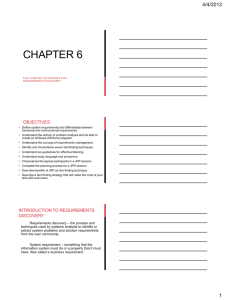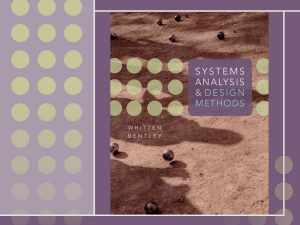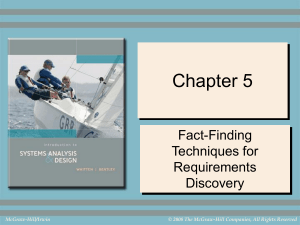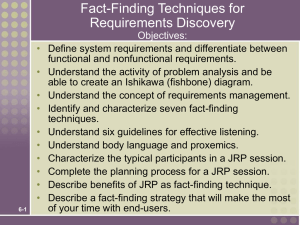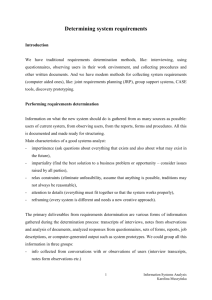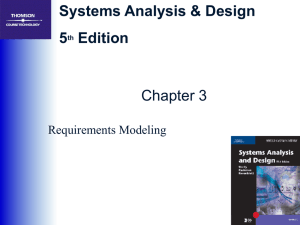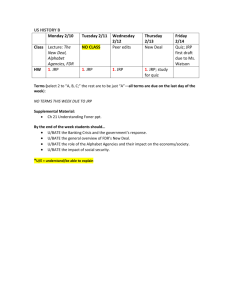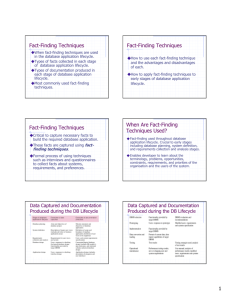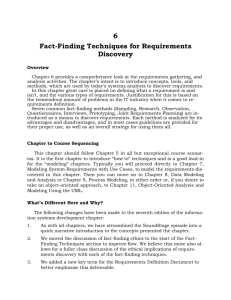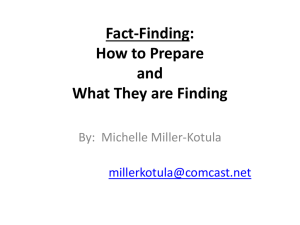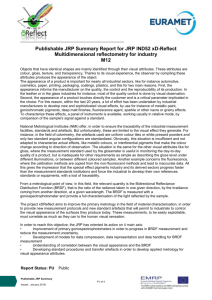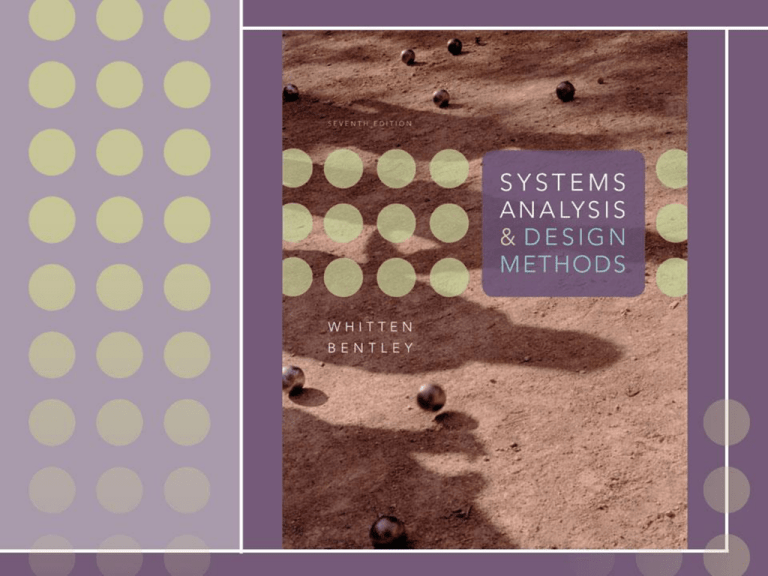
Chapter 6
Fact-Finding
Techniques for
Requirements
Discovery
McGraw-Hill/Irwin
Copyright © 2007 by The McGraw-Hill Companies, Inc. All rights reserved.
Introduction to Requirements
Discovery
Requirements discovery – the process
and techniques used by systems analysts
to identify or extract system problems and
solution requirements from the user
community.
System requirement – something that
the information system must do or a
property that it must have. Also called a
business requirement.
6-2
Functional vs. Nonfunctional
Requirements
Functional requirement - something the
information system must do
Nonfunctional requirement - a property
or quality the system must have
• Performance
• Security
• Costs
6-3
Results of Incorrect
Requirements
6-4
• The system may cost more than projected.
• The system may be delivered later than
promised.
• The system may not meet the users’
expectations and they may not to use it.
• Once in production, costs of maintaining and
enhancing system may be excessively high.
• The system may be unreliable and prone to
errors and downtime.
• Reputation of IT staff is tarnished as failure will
be perceived as a mistake by the team.
Relative Cost to Fix an Error
6-5
Criteria for System
Requirements
6-6
• Consistent – not conflicting or ambiguous.
• Complete – describe all possible system
inputs and responses.
• Feasible – can be satisfied based on the
available resources and constraints.
• Required – truly needed and fulfill the purpose
of the system.
• Accurate – stated correctly.
• Traceable – directly map to functions and
features of system.
• Verifiable – defined so can be demonstrated
during testing.
Requirements Discovery
Given an understand of problems, the systems
analyst can start to define requirements.
This requires fact-finding.
Fact-finding – the formal process of using
research, meetings, interviews, questionnaires,
sampling, and other techniques to collect
information about system problems, requirements,
and preferences. It is also called information
gathering or data collection.
6-7
Documenting and Analyzing
Requirements
• Documenting the draft requirements
• Use cases
• Decision tables
• Requirements tables
• Analyzing requirements to resolve problems
•
•
•
•
•
Missing requirements
Conflicting requirements
Infeasible requirements
Overlapping requirements
Ambiguous requirements
• Formalizing requirements
6-8
• Requirements definition document
• Communicated to stakeholders or steering body
Requirements Definition
Document
Requirements Definition Document – A formal
document that communicates the requirements
of a proposed system to key stakeholders and
serves as a contract for the systems project.
• Synonyms
•
•
•
•
6-9
Requirements definition report
Requirements statement
Requirements specification
Functional specifications
Sample Requirements
Definition Report Outline
6-10
Requirements Management
Requirements management - the process of
managing change to the requirements.
• Over the lifetime of the project it is very common for
new requirements to emerge and existing
requirements to change.
• Studies have shown that over the life of a project as
much as 50 percent or more of the requirements will
change before the system is put into production.
6-11
Fact-Finding Ethics
• Fact-Finding often brings systems analysts into contact
with sensitive information.
• Company plans
• Employee salaries or medical history
• Customer credit card, social security, or other information
• Ethical behavior
• Systems analysts must not misuse information.
• Systems analysts must protect information from people who
would misuse it.
• Otherwise
6-12
• Systems analyst loses respect, credibility, and confidence of
users and management, impairing ability to do job
• Organization and systems analyst could have legal liability
• Systems analyst could lose job
Seven Fact-Finding Methods
1. Sampling of existing documentation,
forms, and databases.
2. Research and site visits.
3. Observation of the work environment.
4. Questionnaires.
5. Interviews.
6. Prototyping.
7. Joint requirements planning (JRP).
6-13
Sampling Existing
Documentation, Forms, & Files
Sampling –process of collecting a representative
sample of documents, forms, and records.
6-14
• Organization chart
• Memos and other documents that describe the
problem
• Standard operating procedures for current system
• Completed forms
• Manual and computerized screens and reports
• Samples of databases
• Flowcharts and other system documentation
• And more
Things to be Gleaned from
Documents
• Symptoms and causes of problems
• Persons in organization who have
understanding of problem
• Business functions that support the
present system
• Type of data to be collected and reported
by the system
• Questions that need to be covered in
interviews
6-15
Why Sample Completed Rather
than Blank Forms
• Can determine type of data going into each blank
• Can determine size of data going into each blank
• Can determine
which blanks
are not used
or not always
used
• Can see data
relationships
6-16
Determining Sample Size for
Forms
• Sample Size = 0.25 x (Certainty factor/Acceptable error) 2
• Sample Size = 0.25(1.645/0.10) 2 = 68
• Sample Size =0.10(1 – 0.10)(1.645/0.10)2 = 25
Or if analyst
knows 1 in 10
varies from norm.
6-17
Certainty factor from
certainty table. 10%
acceptable error.
Sampling Techniques
Randomization – a sampling technique
characterized by having no predetermined
pattern or plan for selecting sample data.
Stratification – a systematic sampling
technique that attempts to reduce the
variance of the estimates by spreading out the
sampling—for example, choosing documents
or records by formula—and by avoiding very
high or low estimates.
6-18
Observation
Observation – a fact-finding technique wherein
the systems analyst either participates in or
watches a person perform activities to learn
about the system.
Advantages?
Disadvantages?
Work sampling - a fact-finding technique that
involves a large number of observations taken
at random intervals.
6-19
Observation
6-20
Advantages
Disadvantages
• Data gathered can be
very reliable
• Can see exactly what is
being done in complex
tasks
• Relatively inexpensive
compared with other
techniques
• Can do work
measurements
• People may perform
differently when being
observed
• Work observed may not
be representative of
normal conditions
• Timing can be
inconvenient
• Interruptions
• Some tasks not always
performed the same way
• May observe wrong way
of doing things
Observation Guidelines
6-21
• Determine the who, what, where, when, why, and
how of the observation.
• Obtain permission from appropriate supervisors.
• Inform those who will be observed of the purpose
of the observation.
• Keep a low profile.
• Take notes.
• Review observation notes with appropriate
individuals.
• Don't interrupt the individuals at work.
• Don't focus heavily on trivial activities.
• Don't make assumptions.
Joint Requirements Planning
Joint requirements planning (JRP) – a
process whereby highly structured group
meetings are conducted for the purpose of
analyzing problems and defining
requirements.
• JRP is a subset of a more comprehensive
joint application development or JAD
technique that encompasses the entire
systems development process.
6-22
JRP Participants
•
•
•
•
•
6-23
Sponsor
Facilitator
Users and Managers
Scribes
IT Staff
Steps to Plan a JRP Session
1. Selecting a location
• Away from workplace when possible
• Requires several rooms
• Equipped with tables, chairs, whiteboard, overhead
projectors
• Needed computer equipment
2. Selecting the participants
• Each needs release from regular duties
3. Preparing the agenda
• Briefing documentation
• Agenda distributed before each session
6-24
Typical Room Layout for JRP
session
6-25
Guidelines for Conducting
a JRP Session
•
•
•
•
•
•
•
•
Do not unreasonably deviate from the agenda
Stay on schedule
Ensure that the scribe is able to take notes
Avoid the use of technical jargon
Apply conflict resolution skills
Allow for ample breaks
Encourage group consensus
Encourage user and management participation without
allowing individuals to dominate the session
• Make sure that attendees abide by the established
ground rules for the session
6-26
Brainstorming
• Sometimes, one of the goals of a JRP session
is to generate possible ideas to solve a problem.
• Brainstorming is a common approach that is used for
this purpose.
Brainstorming – a technique for generating
ideas by encouraging participants to offer as
many ideas as possible in a short period of time
without any analysis until all the ideas have
been exhausted.
6-27
Brainstorming Guidelines
• Isolate appropriate people in a place that free from
distractions and interruptions.
• Make sure everyone understands purpose of the
meeting.
• Appoint one person to record ideas.
• Remind everyone of brainstorming rules.
• Within a specified time period, team members call out
their ideas as quickly as they can think of them.
• After group has run out of ideas and all ideas have
been recorded, then and only then should ideas be
evaluated.
• Refine, combine, and improve ideas generated earlier.
6-28
Benefits of JRP
• JRP actively involves users and
management in the development project
(encouraging them to take “ownership” in
the project).
• JRP reduces the amount of time required
to develop systems.
• When JRP incorporates prototyping as a
means for confirming requirements and
obtaining design approvals, the benefits of
prototyping are realized
6-29
Fact-Finding Strategy
The purpose of a fact-finding strategy is to plan
how you will get a set of requirements that is:
• sufficiently broad
• sufficiently complete
• sufficiently correct
6-30
An Example Fact-Finding
Strategy
1. Learn from existing documents, forms, reports,
and files.
2. Observe the existing system in action.
3. Design and distribute questionnaires to clear up
issues that aren’t fully understood.
4. Conduct interviews (or group work sessions).
5. Build discovery prototypes for any functional
requirements that are not understood or for
requirements that need to be validated.
6. Follow up to verify facts.
6-31
Group Exercise
• Create a fact-finding strategy for your
project. Justify why your strategy is
appropriate for your project.
• This is due next class.
6-32

